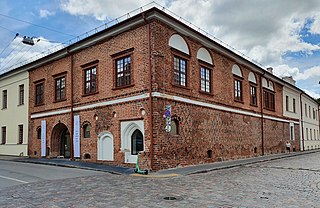
The Ninth Fort is a stronghold in the northern part of Šilainiai elderate, Kaunas, Lithuania. It is a part of the Kaunas Fortress, built in the late 19th century. During the Soviet occupation, the fort was used as a prison and way-station for prisoners being transported to labour camps. After the occupation of Lithuania by Nazi Germany, the fort was used as a place of execution for Jews, captured Soviets, and others.
Kauno diena is a Lithuanian daily newspaper, printed in Kaunas.

St. Michael the Archangel's Church or the Garrison Church is a Roman Catholic church in the city of Kaunas, Lithuania, closing the perspective of the Laisvės alėja, the main pedestrian street. It was built between 1891 and 1895 when Kaunas was part of the Russian Empire, in Neo-Byzantine style largely for the use of the Russian Orthodox garrison of Kaunas Fortress.

The Tadas Ivanauskas Zoological Museum is a museum of zoology, established in Kaunas, Lithuania, in 1919 by Tadas Ivanauskas (1882–1970).

The Vytautas the Great War Museum is a museum in Kaunas, Lithuania. It was built in Art Deco and early functionalism style.

Žaliakalnis Funicular is a funicular railway in Kaunas, Lithuania. Built in 1931, it is the oldest funicular in Lithuania and is among the oldest vehicles of such type in the world still operational. The funicular is made of a wood-paneled coachwork and climbs 142 metres (466 ft) up from behind the Vytautas the Great War Museum to the Basilica of the Resurrection.

The Town Hall of Kaunas stands in the middle of the Town Hall Square at the heart of the Old Town, Kaunas, Lithuania.The structure dates from the 16th century. It houses a Museum of Ceramics.

The Historical Presidential Palace is a Neo-baroque building in the Old Town of Kaunas, Lithuania that served as the Presidential Palace during the interwar years. Today, the palace is a branch of the M. K. Čiurlionis National Art Museum.

Leonidas Donskis was a Lithuanian-Jewish philosopher, political theorist, historian of ideas, social analyst, and political commentator, professor of politics and head of "VDU Academia Cum Laude" at Vytautas Magnus University, Honorary Consul of Finland in Kaunas and deputy chairman of the Lithuanian Jewish Community. He was also the member of the European Parliament (MEP) from 2009 to 2014.

Kaunas Fortress is the remains of a fortress complex in Kaunas, Lithuania. It was constructed and renovated between 1882 and 1915 to protect the Russian Empire's western borders, and was designated a "first-class" fortress in 1887. During World War I, the complex was the largest defensive structure in the entire state, occupying 65 km2 (25 sq mi).

The M. K. Čiurlionis National Art Museum is a group of museums based in Kaunas, Lithuania. It is primarily dedicated to exhibiting and publicizing the works of the painter and musician M.K. Čiurlionis (1875–1911).
Robertas Antinis is a Lithuanian Sculptor, performance artist and poet. He is a winner of the National Culture and Art Prize.

Kaunas International Film Festival is a film festival founded in 2007 by Visos mūzos and held in October each year in Kaunas and Vilnius, Lithuania. It has at times visited other cities in the country, such as Panevėžys and Nida. Ilona Jurkonytė is the festival's artistic director and Tomas Tengmark is its programmer.

The Women Lithuanian Basketball League is the premier professional women's club basketball league in Lithuania. It is composed of 6 teams, and it is a member of the Lithuanian Basketball Federation.

The Old Kaunas Ducal Palace is a building complex at the corner of Aleksoto and Muitinės Streets in Kaunas Old Town, Lithuania. It was a psychiatric hospital, but is now owned by the Kaunas Academy of Arts institute.

Grytė Pintukaitė is a Lithuanian portrait painter, member of the Lithuanian Artists' Association, and member of the Association LATGA - Lithuanian Copyright Society.

The Kaunas Picture Gallery is an art museum based in Kaunas, Lithuania, which is a branch of the M. K. Čiurlionis National Art Museum. It houses part of the works donated by the famous Lithuanian collector Mykolas Žilinskas.
Ramybė Park is a public park in Kaunas, Lithuania, established in 1959 in the territory of the Kaunas City Old Cemetery that was also known as the Carmelite Cemetery. The cemetery was established in 1847 and became the main city cemetery with sections for four different religions – Roman Catholics, Eastern Orthodoxs, Lutherans, and Muslims. During World War I and subsequent Lithuanian Wars of Independence, Russian, German, and Lithuanian soldiers were buried in the cemetery. During the interwar period when Kaunas was the temporary capital of Lithuania, many famous people were buried there and several buildings were constructed on the cemetery's territory. In 1930, a monument to fallen Lithuanian soldiers with a tomb of an unknown soldier was unveiled. Around the same time, a tradition to honor fallen soldiers on the All Saints' Day began.

The Kaunas city wall was a masonry defensive wall in Kaunas, an important city of the Grand Duchy of Lithuania. Its construction began in the early 17th century as a result of Kaunas' prosperity and medieval city's standards, however it was unfinished due to later wars and economic reasons.

The Kaunas Carillon is a carillon in the tower of the Vytautas the Great War Museum in Kaunas, Lithuania. The carillon officially belongs to the Ministry of National Defence of the Republic of Lithuania and Vytautas the Great War Museum. In the interwar period, it was the only carillon in Lithuania, however currently four other carillons are also in Klaipėda, Vilnius, Šakiai, and Gelgaudiškis Manor.

















